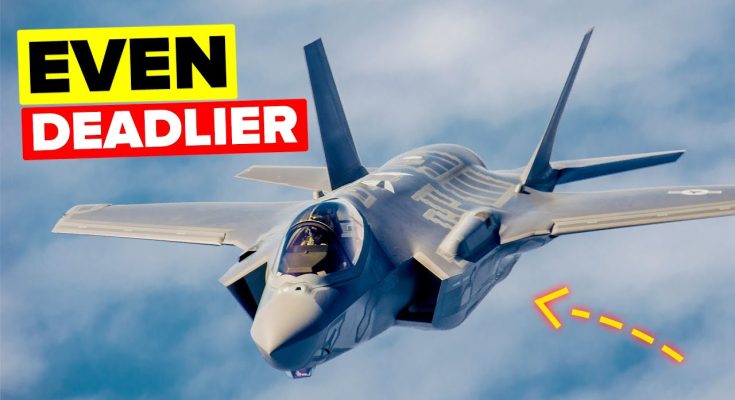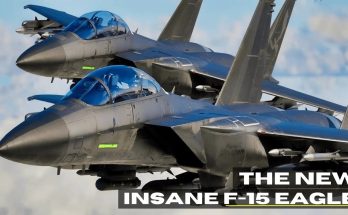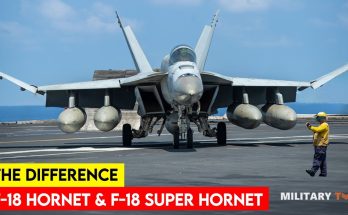The F-35 Lightning II is widely regarded as one of the most deadly and advanced aircraft ever designed. Developed by Lockheed Martin, the F-35 is a fifth-generation multirole stealth fighter that combines cutting-edge technologies, unmatched versatility, and superior combat capabilities. It represents the future of aerial warfare, with three distinct variants: the F-35A (conventional takeoff and landing), the F-35B (short takeoff and vertical landing), and the F-35C (carrier-based). Together, these variants provide an unprecedented level of combat performance for the U.S. military and allied forces around the globe.
Stealth and Superiority in the Skies
One of the F-35’s defining features is its stealth technology, designed to minimize its radar cross-section and make it virtually invisible to enemy radar. This makes the F-35 capable of penetrating highly defended airspace without being detected, giving it a significant advantage in high-risk missions, such as intelligence gathering, precision strikes, and close air support. Its advanced composite materials, special coatings, and carefully engineered airframe all contribute to this remarkable low observability.
Unlike earlier stealth aircraft like the F-22, the F-35 was designed with a focus on multirole capabilities, making it a lethal force not just in air-to-air combat but also in air-to-ground operations. Its combination of stealth, advanced sensors, and precision munitions allows it to strike with pinpoint accuracy, often without ever being detected by the enemy.
Advanced Sensors and Situational Awareness
The F-35’s sensors are arguably its most powerful feature, providing it with unprecedented situational awareness. Equipped with an active electronically scanned array (AESA) radar, electro-optical targeting systems (EOTS), and Distributed Aperture System (DAS), the F-35 can detect and track threats in all directions, day or night, and even through inclement weather. This sensor fusion capability allows the pilot to “see” beyond the aircraft, making it incredibly effective in complex, fast-paced combat environments.
The DAS, for example, gives the pilot a 360-degree view of the battlefield, detecting incoming missiles, enemy aircraft, and ground targets. This system, combined with the aircraft’s radar and infrared sensors, provides real-time data and threat assessments, allowing the pilot to make decisions more quickly and with better information than ever before. The F-35’s ability to gather and analyze such data in real time is one of the reasons it’s considered unmatched in terms of situational awareness.
Versatility and Multirole Capabilities
The F-35’s versatility is one of its most compelling features. Whether engaging in air superiority, ground attack, electronic warfare, or intelligence, surveillance, and reconnaissance (ISR) missions, the F-35 excels in a broad range of roles. Its interoperability with both NATO and allied forces makes it a global asset, capable of operating in joint and coalition operations with a wide variety of aircraft and military assets.
The F-35B, with its ability to perform vertical takeoff and landing (VTOL), can operate from short runways or even the decks of amphibious assault ships, making it a highly flexible asset for the U.S. Marine Corps and other forces with similar needs. This capability enhances its ability to conduct rapid deployments in conflict zones and respond quickly to emerging threats.
The F-35C, designed for carrier operations, is equipped with larger wings, more robust landing gear, and enhanced avionics for use on aircraft carriers, providing naval forces with an unmatched ability to project power across the globe.
Precision Strikes and Combat Effectiveness
The F-35’s weapons systems are second to none. It can carry a wide array of air-to-air missiles, air-to-ground bombs, and precision-guided munitions. Its internal weapons bays maintain its stealth profile, while external hardpoints allow for additional ordnance when stealth is less critical. Some of the most notable munitions the F-35 can carry include the Joint Strike Missile (JSM), GBU-12 Paveway II laser-guided bombs, and the AIM-120 Advanced Medium-Range Air-to-Air Missile (AMRAAM).
With precision strike capabilities, the F-35 is designed to destroy enemy infrastructure, disable enemy aircraft, and neutralize ground targets with pinpoint accuracy, often from extended ranges. The aircraft’s ability to target high-value assets—such as command centers, radar installations, and missile sites—makes it a strategic asset in modern warfare.
A Game-Changer for Modern Warfare
The F-35 is, without a doubt, one of the most deadly and capable aircraft ever built, capable of changing the face of air combat for decades to come. It represents the pinnacle of modern aerial warfare technology, with stealth, sensors, and weapons systems that set new standards for what a fighter aircraft can achieve. Its multirole flexibility, ability to operate from diverse environments, and sensor fusion make it a true force multiplier in both conventional and asymmetric warfare.
With its combination of advanced technology and versatile combat capabilities, the F-35 Lightning II has earned its reputation as one of the most lethal aircraft in the skies. It is not just a fighter jet; it’s a game-changer that will remain a cornerstone of the U.S. military and its allies for years to come.



